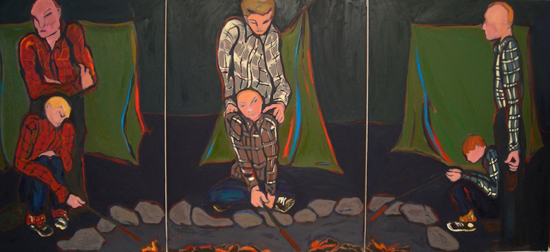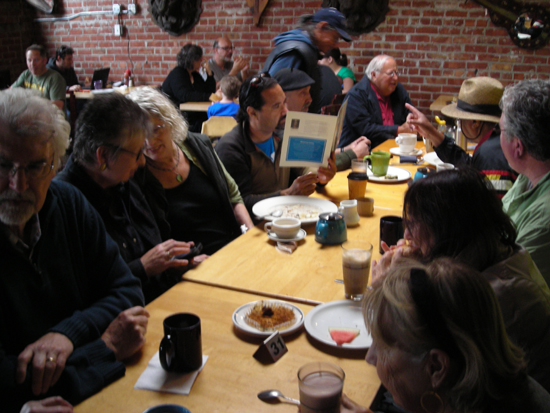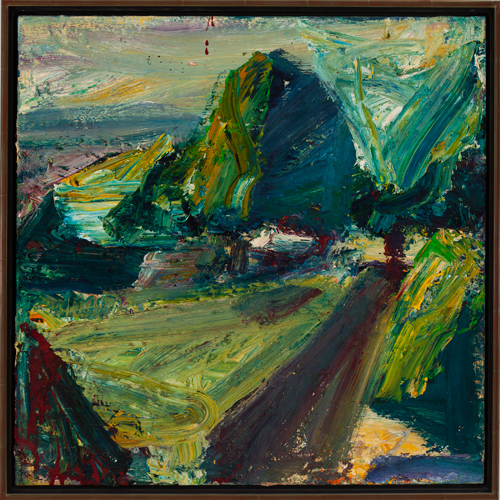The Breakfast Group: Exhibition at Richmond Art Center Toasts Bay Area Institution
The Breakfast Group: Jive and Java at Richmond Art Center
March 22 to May 30, 2014
2540 Barrett Avenue
Richmond, California, 510-620-6772

Jan Wurm, Nocturne: Camping, 2012. Triptych, oil on canvas, 48 x 108 inches. Courtesy of the Artist
We value connections to the past, and the Breakfast Group, a loose affiliation of Berkeley-based artists, sustains a conversation that extends back more than fifty years – a living connection to ancestral figures of the Bay Area movement. There’s a certain look to that art, exemplified most prominently by David Park, Elmer Bischoff, and Richard Diebenkorn, but its specific program is hard to define; perhaps that’s why the conversations have continued so long. This show brings together thirty-one artists currently affiliated with the group, and the works themselves, diverse as they are, engage in dialogue, suggesting that enough common ground persists to merit examination.
The Breakfast Group officially traces its origin to regular Friday lunches that painter Elmer Bischoff arranged with his Berkeley colleague Sid Gordin in the 1960s. These, however, merely extended the weekly drawing sessions and conversations that Bischoff held with Diebenkorn and others, before Diebenkorn left the area, when Fridays were a day off from teaching, and life centered around the campus and their nearby studios. When lunch took too much time out of the workday, meetings shifted to breakfast, at 7 am, and the group expanded to include William Theophilus Brown, Erle Loran, Hassel Smith and other artists teaching at Berkeley.
The group developed spontaneously, with no particular artistic agenda beyond a mutual interest in what people had to say. As it enlarged, eventually to include women, the group moved from one restaurant to another, as establishments closed or their proprietors grew impatient with people sitting so long over coffee.
Bischoff and Loran were cosmopolitan, commenting on art in New York and Europe, but also discussing teaching, new art materials or local politics. Boundaries were fluid – artists like Sid Gordin made both painting and sculpture; gestural forms coexisted with Cubist geometry, along with an undercurrent of Surrealist improvisation. Distinctions between abstraction and representation, while vigorously debated, were not enforced with the same theoretical rigor that Clement Greenberg established back East, and Bischoff’s own work moved from the figure into abstraction during the 1970s.
For Bischoff, breakfast discussions didn’t extend to studio visits; he encouraged debate but kept a more general focus. When group exhibitions inevitably took place – most notably at the Weigand Gallery in Belmont (1987) and at Holy Names College in Oakland (1991) – they offered a chance to celebrate the group’s diversity, and to examine the networks of artistic affiliations that emerged, like the submerged root system of a tree. So it is with the current show: more diverse than ever, the group can consider how it’s grown and how its present configuration reflects the passage of time. Members seem mildly surprised at how big it’s become and how long it’s been going, fueled simply by interest in one another’s conversation; aware of the history of artists’ groups in Paris cafes and New York automats, they wonder if something significant may have transpired.
Shows have also become reminders of artists no longer with the group – the 1990s were marked by Bischoff’s death in 1991 and Loran’s in 1999, and Jerry Carlin, the member with longest standing in the current group, passed away shortly before this exhibition was installed. Appropriately enough, his two works from the 1980s featured here are transcriptions in oils of old family photographs, which he endows with touches of color and personal inflections that bring their subjects back to life. They exemplify the mixing of media and interest in painterly depiction that inspired both the Bay Area Figurative Movement and other Bay Area artists such as Jess.
For many members, affiliation with the Breakfast Group involves allegiance to the Bay Area tradition that mixes figuration and abstraction. Terry St. John, now perhaps the senior member of the group, continues to create densely worked landscapes and figures, extending the legacy of Bischoff and Diebenkorn. His somber landscapes here suggest the depth of experience that informs his immediate response to a site. Lin Fischer goes further in her response to underlying impulses in her landscape-based abstractions, while Donna Fenstermaker creates more succinct plein-air studies that focus on shadows and reflections.
Interchanges with Europe and New York are integral to Bay Area art, dating back to Erle Loran’s inviting Hans Hofmann to teach at Berkeley in the 1930s. The German artist subsequently settled in New York, where his fusion of color with Cubism informed the rise of Abstract Expressionism. His visits to Berkeley, followed by a donation of money and paintings in the 1960s, enhanced ongoing interactions with New York. Here, Tom Schultz’s restlessly shifting rectangles evoke Hofmann’s grid-like compositions, while Arthur Monroe, another New York transplant, brings the gestural energy of Kline and de Kooning to his overall abstractions. A similar tension animates the drawing of Katie Hawkinson’s tightly compressed ellipses.
Abstract Expressionist impulses also emerge in sculpture, in the bronzes and stacked stones of Patricia Bengston-Jones. Her hand-worked slabs with their markings and suggestions of archaic structures hark back to an era before Minimalism and the “death of the object” upstaged such traditional forms. Joe Slusky’s animated armatures of painted steel and the assemblages of Stan Huncilman also exude a playful, improvisatory energy. Kati Casida abstracts gestural forces into origami-like shapes of aluminum, and that expressionist energy carries over into Marvin Lipovsky’s free-flowing sculptures in seductively colored glass.
Dialogues with New York can be complicated; Sandy Walker’s hybrids of figure and landscape, spare and edgy, speak directly to Bay Area art but originate in his exposure to Hans Hofmann’s legacy at the Studio School in New York. And Foad Satterfield owes the inspiration for his dense, overall landscapes, which amplify the scale and ambition of his Bay Area predecessors’, to his study in Louisiana with New York painter Paul Georges; Georges rejected Abstract Expressionism in favor of work from nature, but instilled in students the energy and ambition of the New York School.
Some women in the group have developed more individualized approaches. Nancy Genn and Edythe Bresnahan, who absorbed Berkeley’s varied influences as students, take them in more contemplative directions, composing with architectural structures on richly layered material surfaces. They share a concern for planar luminosity with Carol Ladewig’s color calendars, whose gridded panels chart the phases of the moon, and with Carl Worth’s hard-edge abstractions.
New technology has filtered into some works, but they remain grounded in individual sensibility. Jeanette Bokhour’s digital prints transform and enhance photos of Marvin Lipovsky’s colored glass sculptures, while those of P.G. Meier dissect and reconfigure everyday objects like pens or forks. Kim Thoman goes a step further by digitally “applying” her abstract paintings onto virtual vessels; she presents them here as large prints, although she is prepared to build them with a 3d printer. In more traditional engagements with high-resolution images, John Friedman photographs Nevada’s arid wastes in the manner of New Topographics, while British artist Anthony Holdsworth paints landscapes on site with a detailed realism reminiscent of his countryman, Rackstraw Downes.
Other works take a post-modern stance, but with personal inflections. Byron Spicer links older Bay Area art to the contemporary media era with his appropriated photos of Arnold Schwarzenegger, rendered in dense mosaics of one-inch square paintings. Genn Toffey’s portraits of historic women overlaid with transparent candy wrappers share in the subtle luminosity of Loren Rehbock’s delicate watercolor renderings of models on patterned backgrounds, which reflect his experience in poster design. The cut metal sculptures of Bruce Chaban recall Frank Stella’s compositions, albeit on a more intimate and playful scale, while Guillermo Pulido’s mixed-media constructions with chairs combine playful formal composition with graphic images of political conflict, reminding us of this important component of Berkeley’s culture.
Organization of this show was spearheaded by Jan Wurm, whose paintings blend Bay Area figuration with simplified renderings of men and women against flat backgrounds, which highlight social interactions, with details of clothing and mannerisms that lend them an ethnographic dimension. Difficult to categorize, they exemplify the combination of high sophistication and improvisatory play that characterizes the Bay Area scene, as do Robert Simons’ hand-painted prints, evocative of George Herriman’s Krazy Kat, or Barbara Hazard’s idiosyncratic self-portraits from a mirror cube, which feature animals and multiple self-images in a contemporary version of folk art.
Such is a snapshot of the Breakfast Group today – or Groups, since it is currently split in a dispute between members who prefer Cafe Leila and those faithful to the Vault, a longstanding hang-out, where they maintain an earlier meeting time. The value of conversation and shared information still sustains the expanded group, even as other forces conspire against it. Cuts in education and higher rents have fostered dispersion (Terry St. John offered me comments via Skype from Thailand, where he now maintains a studio for much of the year); artists now commute to teach all over the Bay Area, and few can afford studios close to Berkeley. This has made it more difficult to recruit younger members. A sense of changing demographics and new trends in art lends this event a particularly retrospective and reflective character.
Given the richness of the show, there’s a sense that the gallery system should offer more opportunities for these artists to exhibit; there too, however, rising rents and the invasion of high-tech corporations have created an unfavorable climate. At least for now, weekly breakfasts continue, enacting a cultural form that can be transported and recreated in new locations. Celebration of the Breakfast Group at the Richmond Art Center continues through May, featuring weekly spotlights on selected members accompanied by potluck breakfasts, artist’s talks and workshops.

Top image: Terry St. John, China Camp, 2002. Oil on canvas, 24 x 24 inches. Courtesy of the Artist/ Dolby Chadwick Gallery

